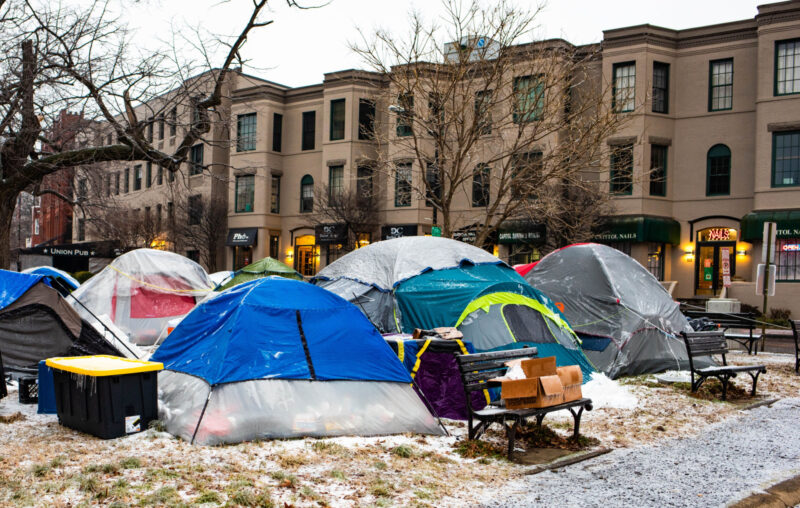The Sad Irony of “Not In My Backyard” (NIMBY)

On my way to work one morning, a homeless man, clearly deranged and mentally unstable, cursed at the wind and sat down in the middle of the street, with me as his only observer. Sadly, scenes like this are playing out in thousands of American communities. Tightly regulated housing markets are pushing vulnerable Americans to the margin of society. Once relegated to high-population centers, homelessness has now spilled into America’s suburbs.
But why is this trend worsening? Why do our well-intentioned neighbors — the ones who claim to represent the most downtrodden — elect greater barriers to building housing in their communities? “Not in My Backyard” (NIMBY) is more than a political slogan; It has become a lifestyle that drips with sad irony.
Today, America’s housing crisis has reached record heights. Large American cities, mostly Democratic but some Republican, are scrambling to address the frightening scarcity of affordable housing. The consequences of our chronic housing crunch are now contributing to other ailments plaguing our nation’s health, such as high crime, increased drug abuse, and economic malaise.
In 2021, there was a shortage of 7.3 million affordable homes and rental units, an increase of 500,000 from just two years earlier. A dense thicket of zoning restrictions strangles housing development, pushing home and rental prices ever higher.
A wide consensus has formed in the literature linking zoning regulations to unaffordable housing and worsening homelessness. One influential study by Ed Glaeser and coauthors found that excessive zoning rules like height limitations and historical site preservation status increased housing costs by an average of 50 percent in New York City.
The real puzzle, however, isn’t what’s causing our persistent housing shortage, but rather why so many Americans support policies that make it worse. NIMBY has become a symbol of pride for many — a security blanket protecting community life in a world of constant flux.
Homeowners fear that new construction would immediately reduce their home equity, leaving them worse off. Renters, by contrast, have more of an incentive to promote development in their communities because a boost in housing supply translates to lower rental prices. But homeowners wield greater political authority, as they typically have more invested in their communities and are better organized politically.
A recent study found that renters are more skeptical of housing development, associating an increase in housing supply with elevated rental prices, the opposite of what Economics 101 would predict. In the same study, homeowners responded that they, too, think a boon in housing supply could result in higher prices. Yet homeowners show stronger opposition to new construction, even when that new construction would benefit them according to their own beliefs.
What then, besides economic illiteracy, is driving NIMBY’s attraction? One possible explanation is offered by Michael Hankinson in his paper for the American Political Science Review. He explains that the framing around housing deregulation matters just as much as the deregulation itself. In many cities, a majority of residents favor increased housing development, but because local institutions are better organized and politically efficient, support for NIMBYism plays an outsized role in maintaining the status quo. So instead of amplifying local voices, it may make more sense to “harness citywide support for new housing through ballot initiatives and citywide campaigns,” Hankinson writes.
It’s not just empowering our broader political institutions that matters, though. Recasting the NIMBY debate in social terms would convince even the most ardent NIMBY activist to reconsider. America’s blight with homelessness, for example, can be remedied by increasing the housing supply. Another way to frame it, explains Bryan Caplan, is through the analogy of reverse musical chairs. When we allow new construction, we unlock cheaper housing that was previously occupied by richer homeowners. Instead of taking away housing units (chairs), we are adding units (chairs) that enable everyone in the housing market (the game of musical chairs) to benefit.
Most notably, NIMBYers worry that new housing developments in their communities threaten their way of life. Kids will no longer be able to play in the streets. High traffic will invade suburban life. Schools will be flooded with new students. Or so the thinking goes. While these concerns shouldn’t be dismissed, they ignore the moderate solutions that address NIMBY fears. Eliminating zoning regulations that restrict the development of accessory dwelling units, small-lot single-family houses, duplexes, triplexes, and fourplexes, for example, would both stimulate housing supply and preserve the local community conditions that accompany lower-density housing. According to scholars at the American Enterprise Institute, these reforms could “contribute eight million additional housing units to the total stock over the next 20 years.”
We should take the concerns of our NIMBY neighbors seriously while reminding them that resisting housing development only adds to the societal challenges we face, especially for the most vulnerable Americans. No matter your political persuasion, finding ways to let builders build not only unlocks our country’s housing potential, it also welcomes those on the margin of society back into American life. This “pro-build” approach is the best and only way to ensure that no one is left on the sidewalk.










